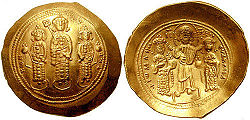Andronikos Dukas (co-emperor)

Andronikos Dukas ( Middle Greek Ἀνδρόνικος Δούκας ; * around 1058; † probably 1077) was a Byzantine prince and co-emperor since 1068.
Life
Andronikos came from the Byzantine noble family of the Dukai , who were among the oldest in the empire. He was the second eldest son of the Emperor Constantine X and the Eudokia Makrembolitissa . He had two brothers, the older Michael and the younger, purple-born Konstantios , as well as three sisters named Anna, Theodora (who later became the wife of the Venetian Doge Domenico Silvo ) and Zoe. In contrast to his two brothers, Andronikos was apparently not made co-emperor ( Symbasileus ) by his father in 1060 .
When Constantine X died in 1067, Andronikos was only about nine years old. Since the nominal heir to the throne Michael VII was also a minor, his mother Eudokia took over the reign. In practice, however, the monk , historian and statesman Michael Psellos and Andronikos' uncle, the emperor Johannes Dukas, ruled . In view of the massive military threat to the empire from outside, the military aristocracy did not want to leave the government to a boy, a woman or a monk, but instead advocated strong military rule . Eudokia was therefore urged to marry the Cappadocian magnate and victorious general Romanos Diogenes .
Through this marriage, Romanos Diogenes became the stepfather of Andronikos in 1068 and was subsequently crowned Emperor of the Byzantine Empire as Romanos IV. He ruled from 1068 to 1071 de facto as the main emperor and thus excluded the sons of his predecessor who were entitled to inheritance, Michael and Konstantios, as mere co-emperors, although Andronikos now also formally advanced to the ruling college. This happened perhaps at Eudocia's request, but also for dynastic considerations: the large number of co-emperors, which soon also included Eudocia's two young sons of Romanus, Leon and Nikephorus , weakened the position of the sons of Constantine X in favor of the chief emperor. Andronikos accompanied his stepfather in 1068 on his punitive expedition against the Seljuks to Sebasteia , where he stayed behind with the infantry team ; According to Attaleiates , the young co-emperor was treated like a hostage by Romanos .
Romanos IV suffered a crushing defeat against the Seljuks with his army in the Battle of Manzikert on August 26, 1071 and was taken prisoner. His opponents, under the leadership of Emperor Johannes Dukas and Finance Minister Nikephoritzes , used this opportunity to declare him deposed and to occupy the throne again. Andronikos' older brother Michael, who had been nominally emperor since 1067, was proclaimed sole ruler and crowned on October 24, 1071. Andronikos and Konstantios were temporarily removed from the palace , but were allowed to retain their imperial rank; her mother Eudokia was put in a monastery. In August 1074 Andronikos signed with Michael VII., Constantius and the patriarch John the Chrysobull about the alliance with Robert Guiscard against the Seljuks.
When Michael VII renounced the throne on January 7, 1078 under the pressure of the usurpers Nikephoros Botaneiates and Nikephoros Bryennios in favor of his youngest brother Konstantios, Andronikos - contrary to the statements made by Attaleiates and Skylitzes Continuatus - probably no longer lived. His marriage to a woman whose name was unknown and who died soon after him (possibly a Hungarian princess) remained childless.
swell
- Michael Attaleiates 77-78; 100-106; 200; 304
- Michael Glykas 608
- Michael Psellos , Chronographia 7a, 20-21; b, 4-8; c 14; Andronikos 14-15 and 165; Robert 49-50
- Skylitzes Continuatus 118; 124; 127; 184
- John Zonaras 18: 9-16
literature
- Alexander Canduci: Triumph and Tragedy - The Rise and Fall of Rome's Immortal Emperors. Murdoch Books, Sydney 2010, ISBN 978-1-74196-598-8 .
- Thomas Conley: The Alleged "Synopsis" of Aristotle's Rhetoric by John Italos and its Place in the Byzantine Reception of Aristotle. In: Gilbert Dahan, Irène Rosier-Catach: La rhetorique d'Aristote: traditions et commentaires de l'Antiquité au XVIIe siècle. Vrin, Paris 1998, ISBN 2-7116-1307-0 , pp. 49-64.
- Lynda Garland: Byzantine Empresses. Women and Power in Byzantium, AD 527-1204. Routledge, New York / London 1999, ISBN 978-0-415-14688-3 , pp. 173-174.
- Alexander P. Kazhdan (Ed.): The Oxford Dictionary of Byzantium . Oxford University Press, New York NY 1991, ISBN 0-19-504652-8 , p. 656.
- Georg Ostrogorsky : Byzantine History 324–1453. 2nd Edition. Verlag CH Beck, Munich 2006, ISBN 3-406-39759-X , pp. 290-291.
Web links
- Andronikos Doukas in the Prosopography of the Byzantine World
- Charles Cawley: Medieval Lands, in Foundation for Medieval Genealogy: “Byzantium 1057-1204”; Doukas
Remarks
- ^ Zonaras (18, 9) and Skylitzes Cont. (118, 7) claim that Andronikos had already [1060] been made co-emperor together with Michael and Konstantios, but the statements in Psellos and Attaleiates as well as the numismatic findings speak against this.
- ↑ These authors claim that after his coronation in 1078 Nikephoros Botaneiates treated the mother and siblings of the abdicated emperor, including Andronikos, with exquisite friendliness and bestowed them with high honors, but this information is likely to be panegyric .
| personal data | |
|---|---|
| SURNAME | Andronikos Dukas |
| ALTERNATIVE NAMES | Ἀνδρόνικος Δούκας (Middle Greek) |
| BRIEF DESCRIPTION | Byzantine co-emperor |
| DATE OF BIRTH | around 1058 |
| DATE OF DEATH | uncertain: 1077 |